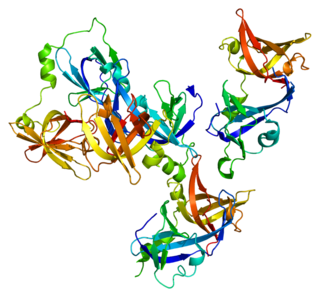Phosphatidylinositol binding clathrin assembly protein, also known as PICALM, is a protein which in humans is encoded by the PICALM gene. [5]
Phosphatidylinositol binding clathrin assembly protein, also known as PICALM, is a protein which in humans is encoded by the PICALM gene. [5]
In humans, certain alleles of this gene have been statistically associated with an increased risk of developing late-onset Alzheimer's disease. [7]
AP180 is a protein that plays an important role in clathrin-mediated endocytosis of synaptic vesicles. It is capable of simultaneously binding both membrane lipids and clathrin and is therefore thought to recruit clathrin to the membrane of newly invaginating vesicles. In Drosophila melanogaster, deletion of the AP180 homologue, leads to enlarged but much fewer vesicles and an overall decrease in transmitter release. In D. melanogaster it was also shown that AP180 is also required for either recycling vesicle proteins and/or maintaining the distribution of both vesicle and synaptic proteins in the nerve terminal. A ubiquitous form of the protein in mammals, CALM, is named after its association with myeloid and lymphoid leukemias where some translocations map to this gene. The C-terminus of AP180 is a powerful and specific inhibitor of clathrin-mediated endocytosis.

ETV6 protein is a transcription factor that in humans is encoded by the ETV6 gene. The ETV6 protein regulates the development and growth of diverse cell types, particularly those of hematological tissues. However, its gene, ETV6 frequently suffers various mutations that lead to an array of potentially lethal cancers, i.e., ETV6 is a clinically significant proto-oncogene in that it can fuse with other genes to drive the development and/or progression of certain cancers. However, ETV6 is also an anti-oncogene or tumor suppressor gene in that mutations in it that encode for a truncated and therefore inactive protein are also associated with certain types of cancers.

MN1 is a gene found on human chromosome 22, with gene map locus 22q12.3-qter. Its official full name is meningioma 1 because it is disrupted by a balanced translocation (4;22) in a meningioma.

AP-2 complex subunit alpha-1 is a protein that in humans is encoded by the AP2A1 gene.

Core-binding factor subunit beta is a protein that in humans is encoded by the CBFB gene.

Histone-lysine N-methyltransferase 2A also known as acute lymphoblastic leukemia 1 (ALL-1), myeloid/lymphoid or mixed-lineage leukemia1 (MLL1), or zinc finger protein HRX (HRX) is an enzyme that in humans is encoded by the KMT2A gene.

Clathrin heavy chain 1 is a protein that in humans is encoded by the CLTC gene.

ERG is an oncogene. ERG is a member of the ETS family of transcription factors. The ERG gene encodes for a protein, also called ERG, that functions as a transcriptional regulator. Genes in the ETS family regulate embryonic development, cell proliferation, differentiation, angiogenesis, inflammation, and apoptosis.

Gamma-interferon-inducible protein Ifi-16 (Ifi-16) also known as interferon-inducible myeloid differentiation transcriptional activator is a protein that in humans is encoded by the IFI16 gene.

Factor interacting with PAPOLA and CPSF1 is a protein that in humans is encoded by the FIP1L1 gene. A medically important aspect of the FIP1L1 gene is its fusion with other genes to form fusion genes which cause clonal hypereosinophilia and leukemic diseases in humans.

Homeobox protein Hox-B3 is a protein that in humans is encoded by the HOXB3 gene.

Clathrin coat assembly protein AP180 is a protein that in humans is encoded by the SNAP91 gene.

K(lysine) acetyltransferase 6A (KAT6A), is an enzyme that, in humans, is encoded by the KAT6A gene. This gene is located on human chromosome 8, band 8p11.21.

Protein AF-10 is a protein that in humans is encoded by the MLLT10 gene.

Protein AF-9 is a protein that in humans is encoded by the MLLT3 gene.

Protein ENL is a protein that in humans is encoded by the MLLT1 gene.

Pre-B-cell leukemia transcription factor 3 is a protein that in humans is encoded by the PBX3 gene.

Myeloid/lymphoid or mixed-lineage leukemia 4, also known as MLL4, is a human gene.

Myeloid leukemia factor 1 is a protein that in humans is encoded by the MLF1 gene.

Tet methylcytosine dioxygenase 2 (TET2) is a human gene. It resides at chromosome 4q24, in a region showing recurrent microdeletions and copy-neutral loss of heterozygosity (CN-LOH) in patients with diverse myeloid malignancies.